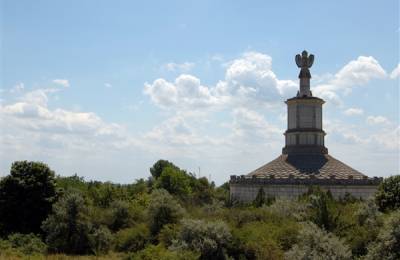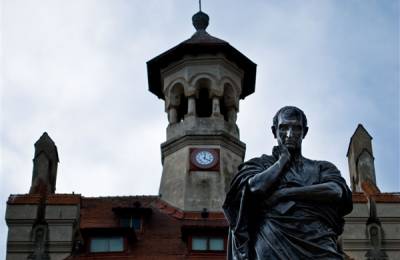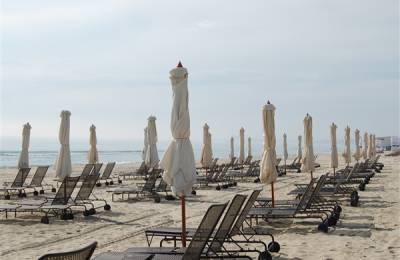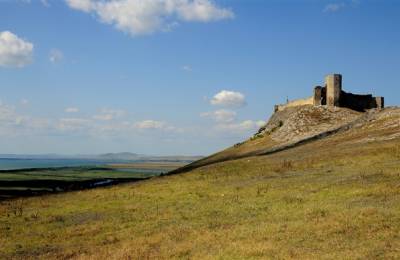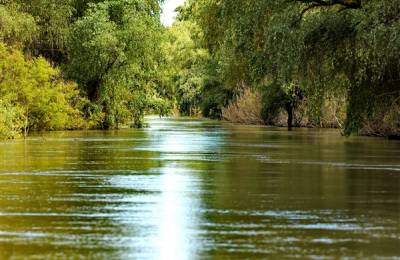Description
The famous expression unity in diversity founds its place here better that anywhere.
On this land are over 20 cultures that coexist each of them keeping its one traditions conscientious.
Dobrogea is truly romanian land as it is a Turkish one to or greek just to mention some of the nations that coexist in Dobrogea established between the Danube Delta and the Black Sea.
This is the reasons why Dobrogea offers unprecedented culinary experiences. The most important dish is fish coocked in various ways according to the traditions or customs and culture. For example the fish soup has different tastes.
This is the reasons why Dobrogea offers unprecedented culinary experiences. The most important dish is fish coocked in various ways according to the traditions or customs and culture. For example the fish soup has different tastes.
Attractions
Danube Delta
The waters of the Danube, which flow into the Black Sea, form the largest and best preserved of Europe's deltas. The Danube delta hosts over 300 species of birds as well as 45 freshwater fish species in its numerous lakes and marshes.
The reserve is vast in European terms with numerous freshwater Lakes interconnected by narrow channels featuring huge expanses of aquatic vegetation. This is the largest continuous marshland on Europe and the second-largest delta (the Volga being the largest), which includes the greatest stretch of reedbeds in the world. The marsh vegetation is dominated by reeds which form floating or fixed islands of decaying vegetation Reeds cover some 1,700 km2 and the floating reed islands (plaur ) 1,000 km2 , whereas the total area not inundated is only 148 km2 . The Razelm-Sinoie complex to the south comprises several large brackish lagoons separated from the sea by a sandbar. The overall basic hydrological and ecological system of the delta, although strongly degraded, is intact.
Forest elements are best observed in Letea Forest where a series of bands occur along dunes up to 250 m long and 10 m wide. The delta has been classified into 12 habitat types as follows: aquatic, lakes covered with flooded reedbeds; 'plaur', flooded islets; flooded reeds and willows; riverine forest of willows and poplars; cane-fields; sandy and muddy beaches; wet meadows; dry meadows (arid); human settlements; sandy and rocky areas; steep banks; and forests on high ground.
Over 300 species of bird have been recorded, of which over 176 species breed, the most important being cormorant, pygmy cormorant, white pelican and Dalmatian pelican. The delta is very important for fish, with 45 fresh water species present. Otter and weasel are to be found on the floating islands. The Danube Delta is a remarkable alluvial feature constituting critical habitat for migratory birds and other animals.
Constanta
Constanta, being founded as a city almost 2600 years ago, isone of the oldest attested cities in Romania and is the biggest port at the Black Sea (third largest in Europe) and is also the fourth largest city in Romania with its 400,000 inhabitants. Constanta was founded by the Greeks as a port on the Black Coast for trading with inland people and called Tomis (VIth c. BC). The city was renamed later after Constantina, niece of Constantine the Great (274-337). It was still a flourishing port city in the Xth and XIth centuries trading with the Byzantine Empire and the city of Genoa.
Tomis, the oldest living city in Romania
Constanţa (historical names: Tomis, Greek: Κωνστάντια or Konstantia, Turkish: Köstence, Bulgarian: Кюстенджа) is the oldest living city in Romania, founded around 600 BC. The city is located on the Black Sea coast. A number of inscriptions found in the town and its vicinity show that Constanţa lies where once Tomis stood. Tomis (also called Tomi) was a Greek colony in the province of Scythia Minor on the Black Sea's shore, founded around 600 BC for commercial exchanges with the local Getic populations.
The city was afterwards included in the Province of Moesia, and, from the time of Diocletian, in Scythia Minor, of which it was the metropolis. After the split of the Roman Empire, Tomis fell under the rule of Byzantine Empire. During Mauritius's Balkan campaigns, Tomis was besieged by the Avars in the winter of 597/598. Tomis was later renamed to Constantiana in honour of Constantia, the half-sister of Constantine the Great (274-337). The earliest known usage of this name was "Κωνστάντια" ("Constantia") in 950. The city lay at the seaward end of the Great Wall of Trajan, and has evidently been surrounded by fortifications of its own.
Vestiges of the old civilizations is found today almost everywhere in the city. In Constanţa one can see today the ruins of the Roman wall which closed the North-western part of the fortress and the ruins of the gates from West and North, on which was the exit from the fortress. The Roman edifice, the most precious architectural complex discovered, is from 3-4 centuries; the floor of this edifice with thick and high walls is formed by colored mosaic pieces, the drawing representing geometrical and floral figures. Considering the artistical conceptions and its dimensions, the mosaic from Constanta is one of the first of the kind in the world. It seams that the building served for trade, being also a place for delivery and deposit (at the middle and underground levels were storehouses for goods and a little market place). Many vestiges of the Tomis fortress are found in the city museum, among them being some special pieces like: the marble statue of the Godess Fortuna, the city protectress, with Pontos, the Black Sea (Pontus Euxinus) God.
The city was afterwards included in the Province of Moesia, and, from the time of Diocletian, in Scythia Minor, of which it was the metropolis. After the split of the Roman Empire, Tomis fell under the rule of Byzantine Empire. During Mauritius's Balkan campaigns, Tomis was besieged by the Avars in the winter of 597/598. Tomis was later renamed to Constantiana in honour of Constantia, the half-sister of Constantine the Great (274-337). The earliest known usage of this name was "Κωνστάντια" ("Constantia") in 950. The city lay at the seaward end of the Great Wall of Trajan, and has evidently been surrounded by fortifications of its own.
Vestiges of the old civilizations is found today almost everywhere in the city. In Constanţa one can see today the ruins of the Roman wall which closed the North-western part of the fortress and the ruins of the gates from West and North, on which was the exit from the fortress. The Roman edifice, the most precious architectural complex discovered, is from 3-4 centuries; the floor of this edifice with thick and high walls is formed by colored mosaic pieces, the drawing representing geometrical and floral figures. Considering the artistical conceptions and its dimensions, the mosaic from Constanta is one of the first of the kind in the world. It seams that the building served for trade, being also a place for delivery and deposit (at the middle and underground levels were storehouses for goods and a little market place). Many vestiges of the Tomis fortress are found in the city museum, among them being some special pieces like: the marble statue of the Godess Fortuna, the city protectress, with Pontos, the Black Sea (Pontus Euxinus) God.
Constanta Casino
The Casino's history begins in 1880, shortly after the Independence War with the Ottoman Empire (1877). The Casino was one of the first buildings in the city, almost immediately after that city was taken by the Romanian government and changed its name from the turkish Kustenge in Constanţa. At that time, the Casino was called Cazin or Kursaal and was just a primitive construction of brick and wood, built near the Genoese Lighthouse, at the end of Elisabeta Boulevard - the only boulevard in Constanţa at the time. The Casino had a ballroom, two reading rooms where the tourists could read newspapers as Telegraf, Le Figaro and L'Ilustration, two games rooms and a terrace at seaside.
Since 1903, the mayor and the prefect of Constanţa intended to build a modern Casino, like those on the French riviera. The architect who designed the new building was Daniel Renard, a Romanian architect with French origins, aged 32, graduate of the School of Fine Arts in Paris, who projected the Casino in the Art Nouveau style, thus being one of the promoters of this artistic style in Romania. The construction was begun in 1907 and was completed in 1910. On March 15, 1911, The City Council authorized gambling, and the place was equipped with two billiard tables and 17 round tables for card games. In a short time the Constanţa Casino has become one of the best known establishments of its kind in Europe, being preferred by the gamblers coming here, incognito, from all over the world. The Casino issue was debated even in the Romanian Parliament, but no matter how strong were those who opposed to its existence, this building continued to be operated under its original destination. Gambling was not prohibited, it is also the Casino's attraction construction and purpose. During the First World War he was turned into a hospital, but it was intensely bombed. In the interwar period it has returned to its destination. Today, the Casino continues to exist at the seaside, pending for the luxury of old times.
The Black Sea Resorts
From North to South, from the Chilia branch of the Danube Delta the border with Bulgaria, these are the Romanian resorts on the Black Sea coast: Navodari, Mamaia, Constanta, Eforie Nord, Eforie Sud, Techirghiol, Costinesti, Olimp, Neptun, Jupiter, Aurora, Venus, Saturn, Mangalia, 2 Mai and Vama Veche.
Mamaia
Mamaia is the biggest and most beautiful summer resort on the Romanian Black Sea shore. Named "The Pearl of the Romanian Riviera", it is the oldest Romanian seaside resort (1906). It is situated north-east of Constanta. Mamaia has almost no full time residents, being populated mostly during summer. It is 8 km (5 miles) in length and only 300 m in width, being a strip of land between the Black Sea and Lake Siutghiol. It is especially suited for families with children.

